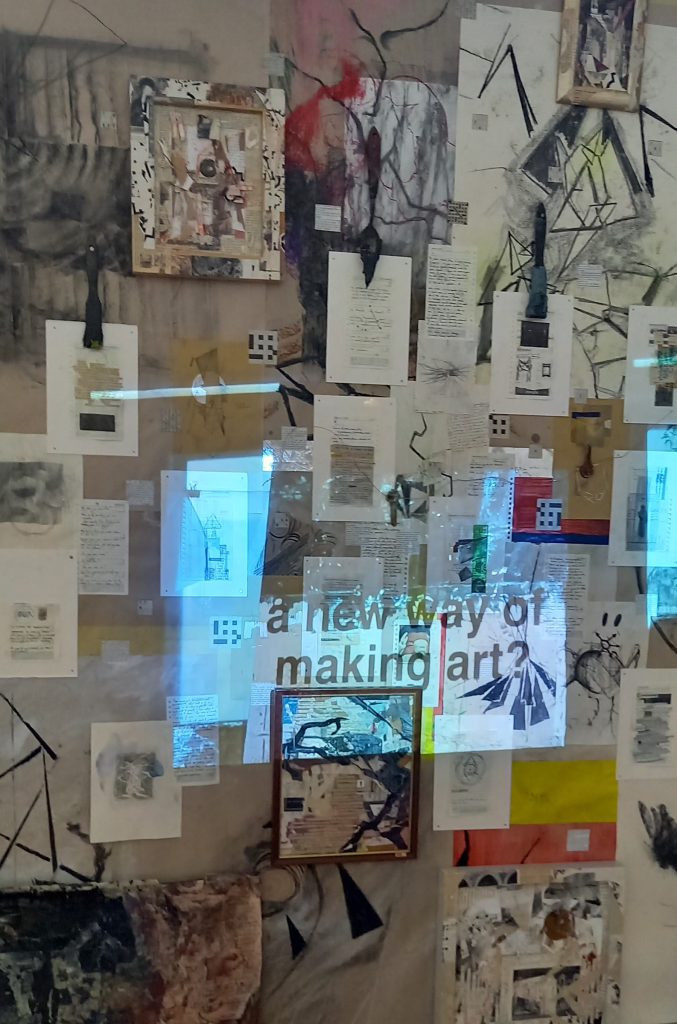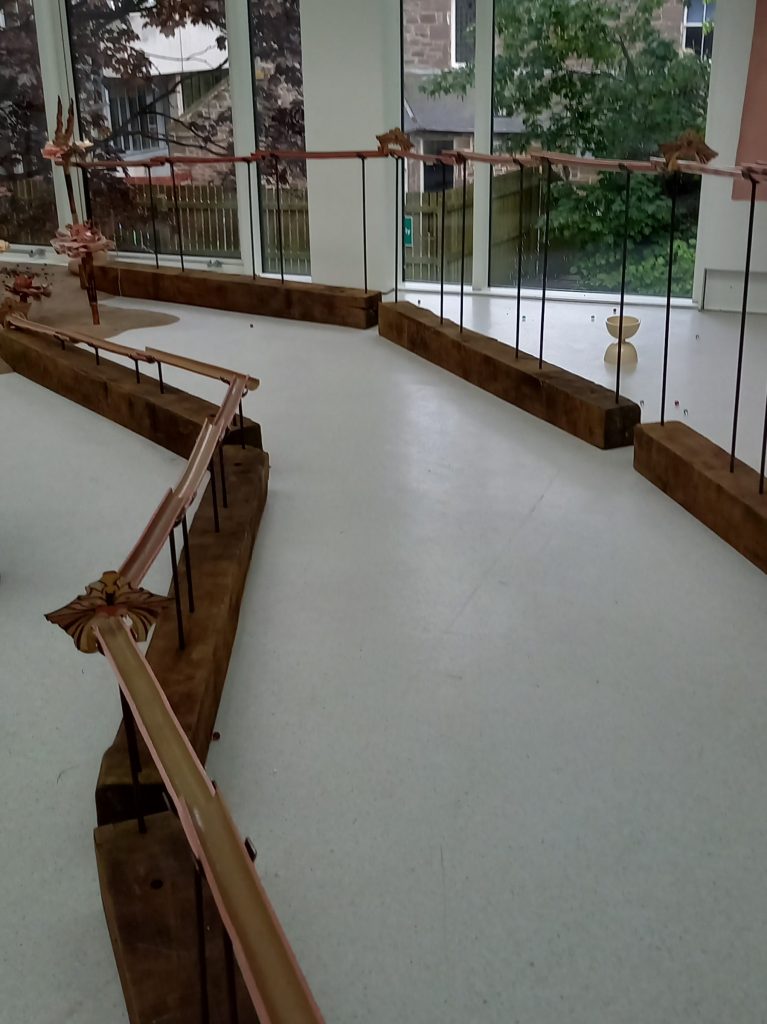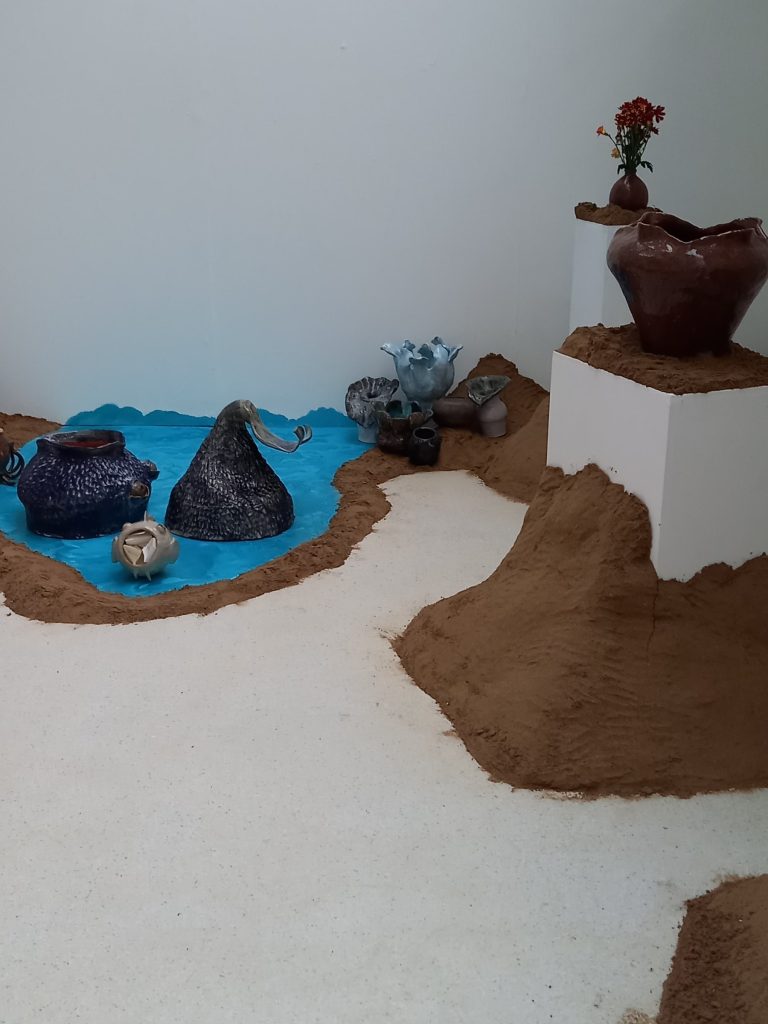DJCAD Degree Show 2023: Art & Philosophy
Crawford and Matthew Buildings
19 – 28 May 2023
The Art & Philosophy graduates’ exhibitions are spread over a number of locations in both the Crawford and Matthew buildings. This year especially, it makes it difficult to view all of the graduates’ work. It also makes it impossible to view all of the work together. Each of the students in this year’s cohort has taken a very individual approach to their project. Many are concerned with the global climate and environmental crisis, but they explore these concepts using highly disparate methods and materials.
Jaeden Cargill makes large gestural paintings and installations which incorporate collage, montage and video overlaid to create dynamic moving images. The paintings suggest a succession of splintered images, events and concepts that recall the thinking of Deleuze and Bergmann. Eve McGovern Miller’s work concerns the damage to the environment by human intervention and exploitation. She uses sculpture, drawing and film to explore this theme. She is particularly interested in the Tay river basin and the landscapes within the catchment area. Her work meditates on natural substances such as water and salt to reflect on historical methods of food preservation and subsistence. Her sculptures incorporate natural fibres such as sheep’s wool. Her film work depicts heather moors and other wild landscapes of Tayside.
Emily Wells uses drawing and digital media to explore the link between place and spirituality. She has based her final work on a place of Pagan worship in Fife, known as Dunino Den. She has created two large digital drawings of the Den and some of the artifacts left behind as offerings to the spirits believed to inhabit the Den, spending considerable time drawing en plein air. She names this work as an ‘Offering’ in itself.
Annie Flora Watson Donaldson uses sculpture and constructed textiles to create a large ‘playspace’, containing games invented by the artist to convey a sense of what she calls a ‘carnivalesque aesthetic’. She has constructed two sets of long troughs on spindly frames, into which the player drops marbles, which roll down the shallow-inclined troughs, simulating a race. There is also a wooden roundabout laid within the playspace along with ceramic pigs’ heads on sticks. The colour theme throughout is of flesh tones, invoking a sense of warmth and fun.
Morgan Barnett’s work focuses on memory, perception and heritage. He uses photography and printmaking to recreate his experiences of growing up on the East coast of Scotland and on mainland Orkney. He uses source material collected by his grandparents to evoke a sense of time and deep connection with people and places. His dark, grainy images are mainly monochrome, suggesting old black and white photographs of his grandparents’ youth.
Persephone Grace Russell’s installation, Fishtopia’, takes the viewer into a fantastical ‘land’ of sea creatures and objects. She works mainly in ceramic and there are several large terracotta urns placed throughout the space. Pastel-coloured paintings on paper bedeck the walls, incorporating playful fish motifs and phrases, such as ‘write a wish and feed it to the fish’. Overall, the atmosphere is light and humorous, but as in the work of Donaldson, the viewer suspects that this apparent escapism overlays a deep concern for the Biosphere.
Anna Brodie’s large installation, ‘The Dance’, attempts to convey the sense of the inter-connectedness of human and non-human life. Her large branch-like structures are constructed from wood, linen, paper and wool. They are arranged vertically and by means of motors hidden within the ceiling, rotate all at once. The structures evoke humans, plants and wraith-like beings engaged in a complex dance.
Jenny Gorrod




Leave a Reply